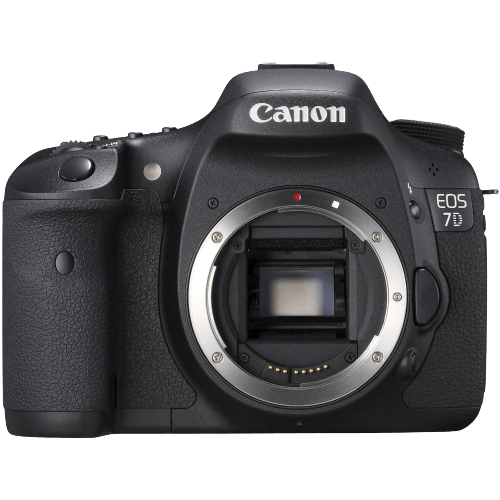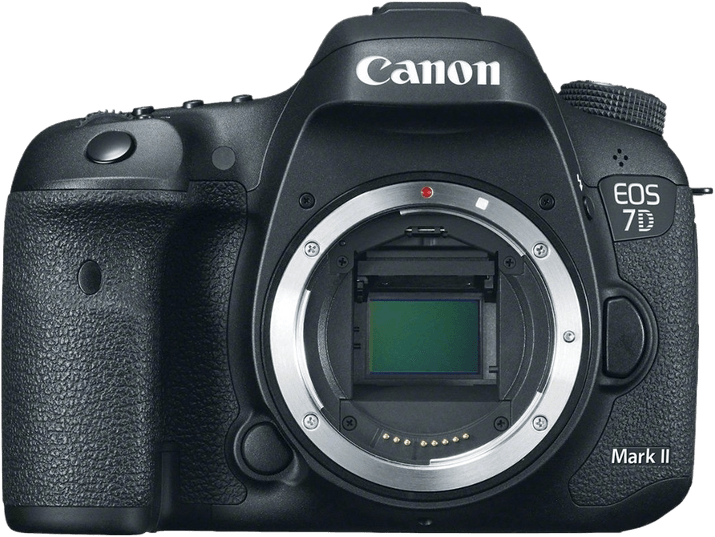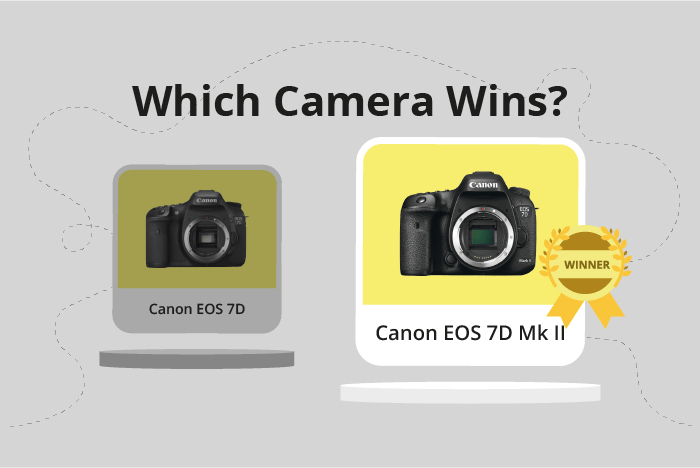Canon EOS 7D vs EOS 7D Mark II Comparison
Canon EOS 7D

Canon EOS 7D Mark II

The Canon EOS 7D Mark II outperforms the Canon EOS 7D with a score of 60/100 compared to 45/100. Both cameras are DSLR types, announced in September, with the 7D released in 2009 and the 7D Mark II in 2014. They share similar dimensions, with the 7D measuring 148 x 111 x 74mm and weighing 860g, while the 7D Mark II is slightly larger and heavier at 149 x 112 x 78mm and 910g.
The 7D Mark II has a lower launch price of $1800, making it more affordable than the 7D’s initial price of $1974. Despite the lower price, the 7D Mark II’s higher score indicates it offers better performance and features.
The Canon EOS 7D, however, still has its merits. It is lighter and slightly more compact than the Mark II, which might be preferable for some users.
Taking all factors into account, the Canon EOS 7D Mark II is the better option due to its improved performance, features, and affordability. The Canon EOS 7D may still be suitable for those who value a lighter and more compact camera.
Canon EOS 7D vs EOS 7D Mark II Overview and Optics
The Canon EOS 7D Mark II outperforms the Canon EOS 7D in optics with a score of 61/100 compared to the 7D’s 43/100. Both cameras share common specifications, such as an APS-C sensor size, CMOS sensor type, Canon EF-S lens mount, and lack of image stabilization.
The 7D Mark II surpasses the 7D in several aspects. It has a higher megapixel count of 20.2 compared to the 7D’s 18, allowing for greater image resolution. The shooting speed is also faster at 10 frames per second (fps) compared to the 7D’s 8 fps, enabling the capture of fast-moving subjects with more precision. Additionally, the 7D Mark II features a more advanced processor, the Dual Digic 6, which results in improved image processing and overall performance. The DXOMARK score for the 7D Mark II’s sensor is 70, which is higher than the 7D’s score of 66, indicating better image quality.
On the other hand, the Canon EOS 7D does not offer any significant advantages over the 7D Mark II in terms of optics. Both cameras have the same lens mount and lack image stabilization, which means that the choice of lenses and the need for a steady hand or tripod will be the same for both models.
Considering the higher score and superior specifications of the Canon EOS 7D Mark II, it is the better choice in terms of optics. The increased megapixel count, faster shooting speed, advanced processor, and higher DXOMARK sensor score make it a more powerful and versatile camera compared to the Canon EOS 7D.
Canon EOS 7D vs EOS 7D Mark II Video Performance
The Canon EOS 7D Mark II wins in the video capabilities comparison, scoring 56/100, while the Canon EOS 7D scores 43/100. Both cameras share common specifications, including Full HD video resolution and maximum video dimensions of 1920 x 1080. However, there are notable differences that make the Canon EOS 7D Mark II a superior choice for video recording.
The Canon EOS 7D Mark II’s higher score is due to its improved video performance, particularly the maximum video frame rate of 60fps. This allows for smoother video playback and the potential for slow-motion footage. In contrast, the Canon EOS 7D has a maximum video frame rate of 30fps, which is half the performance of the 7D Mark II. This difference gives the 7D Mark II a clear advantage in capturing fast-moving subjects or scenes with more fluid motion.
Despite the lower score and frame rate, the Canon EOS 7D still delivers Full HD video quality, making it a suitable option for casual videographers or those on a budget. However, for users seeking improved video capabilities, the 7D Mark II’s higher frame rate offers a significant advantage.
Neither camera has built-in time-lapse functionality, which may be a downside for some users. However, this can be addressed with external intervalometers or software solutions.
Comparing the video capabilities of the Canon EOS 7D and the Canon EOS 7D Mark II, the latter emerges as the superior choice due to its higher frame rate. While both cameras provide Full HD video quality, the 7D Mark II’s 60fps offers smoother playback and greater flexibility in capturing motion. The Canon EOS 7D remains a viable option for those seeking Full HD video on a budget, but the 7D Mark II is the clear winner for users prioritizing video performance.
Canon EOS 7D vs EOS 7D Mark II Features and Benefits
The Canon EOS 7D Mark II is the winner in the features comparison, scoring 57/100, while the Canon EOS 7D scores 54/100. Both cameras have a 3-inch screen size, no touchscreen, and no flip screen. However, the 7D Mark II has a higher screen resolution at 1,040,000 dots compared to the 7D’s 920,000 dots, providing a clearer and more detailed display.
The 7D Mark II also has GPS and WIFI capabilities, allowing for easier geotagging and sharing of photos, while the 7D lacks these features. Both cameras do not have Bluetooth connectivity. The 7D Mark II’s additional features contribute to its higher score and make it a more versatile camera.
The Canon EOS 7D, despite having a lower feature score, still offers a solid performance. Its 3-inch screen size and 920,000-dot resolution provide a good display for reviewing photos. However, it lacks GPS and WIFI, which may be important features for some users. The 7D’s absence of these features does not make it a bad camera, but it does limit its versatility compared to the 7D Mark II.
In comparing the features of the Canon EOS 7D and the Canon EOS 7D Mark II, the 7D Mark II is the superior camera due to its higher screen resolution, GPS, and WIFI capabilities. The Canon EOS 7D is still a good camera, but the 7D Mark II offers a more versatile and convenient experience for photographers.
Canon EOS 7D vs EOS 7D Mark II Storage and Battery
The Canon EOS 7D Mark II outperforms the Canon EOS 7D in storage and battery, scoring 65/100 compared to the 7D’s 35/100. Both cameras share the same battery type (LP-E6) and lack USB charging capabilities. However, the 7D Mark II has an edge with its dual memory card slots, accepting both SD/SDHC/SDXC and Compact Flash cards. This feature allows for more storage options and backup possibilities.
In terms of battery life, the Canon EOS 7D surprisingly surpasses the 7D Mark II, offering 800 shots per charge compared to the 7D Mark II’s 670 shots. This advantage gives the 7D users more time to capture images without needing to recharge or replace the battery.
Despite the 7D’s longer battery life, the 7D Mark II’s dual memory card slots make it the better choice for photographers seeking more storage flexibility and backup options. However, those prioritizing battery life may still find the Canon EOS 7D to be a suitable option.
Alternatives to the Canon EOS 7D and EOS 7D Mark II
Are you still undecided about which camera is right for you? Have a look at these popular comparisons that feature the Canon EOS 7D or the Canon EOS 7D Mark II:

